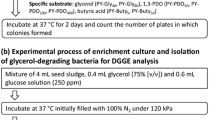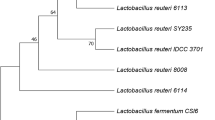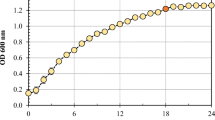Abstract
According to their ability to synthesize 1,3-propanediol from glycerol, two species were isolated from the anoxic mud of a distillery waste-water digestor:Clostridium butyricum andEnterobacter agglomerans. The latter, a facultatively anaerobic gram-negative bacterium, is described for the first time as a microorganism producing 1,3-propanediol from glycerol. The products of glycerol conversion byE. agglomerans were identified using nuclear magnetic resonance. A 20-g/l glycerol solution was fermented mainly to 1,3-propanediol (0.51 mol/mol) and acetate (0.18 mol/mol). Ethanol, formate, lactate and succinate were formed as by-products. Gas production was very low; 1,3-propanediol production perfectly balanced the oxido-reduction state of the microorganism. Acetate was the predominant metabolite generating energy for growth. High-glycerol-concentration fermentations (71 g/l and 100 g/l) resulted in an increase of the 1,3-propanediol yield (0.61 mol/mol) at the expense of lactate and ethamol production. Specific rates of glycerol consumption and 1,3-propanediol and acetate production increased whereas the growth rate decreased. The decreased in ATP yield was linearly correlated with the specific rate of 1,3-propanediol production. Incomplete glycerol consumption (about 40 g/l) was systematically observed when high glycerol concentrations were used. The unbalanced oxido-reduction state, the low carbon recovery and the detection of an unknown compound by HPLC observed in these cases indicate the formation of another metabolite, which is possibly an inhibitory factor.
Similar content being viewed by others
References
Abeles RH, Brownstein AM, Randles CH (1960) β-Hydroxypropionaldehyde, an intermediate in the formation of 1,3-propanediol byAerobacter aerogenes. Biochim Biophys Acta 41:530–531
Biebl H (1991) Glycerol fermentation of 1,3-propanediol byClotridium butyricum. Measurement of product inhibition by use of a pH-auxostat. Appl Microbiol Biotechnol 35:701–705
Bories A, Claret C (1992) Procédés pour l'obtention de produits á activité bactérienne, capable de transformer le glycérol en 1,3-propanediol, souches correspondantes et application á la production industrielle de 1,3-propanediol. French patent FR 9207212
Bories A, Claret C, Soucaille P (1991) Kinetic study and optimisation of the production of dihydroxyacetone from gylcerol suingGluconobacter oxydans. Process Biochem 26:243–248
Bouvet OMM, Lenormand P, Carlier JP, Grimont PAD (1994) Phenotypic diversity of anaerobic glycerol dissimilation shown by seven enterobacterial species. Res Microbiol 145:129–139
Chatelain R (1969) Réduction des nitrites parAlcaligenes odorans var. Viridans. Ann Inst Pasteur (Paris) 116:498–500
Cooper RA, Anderson A (1970) The formation and catabolism of methylglyoxal during glycolysis inEscherichia coli. FEBS Lett 11:273–276
Dabrock B, Bahl H, Gottschalk G (1992) Parameters affecting solvent production byClostridium pasteurianum. Appl Environ Microbiol 58:1233–1239
Eichler B, Schink B (1984) Oxidation of primary aliphatic alcohols byAcetobacterium carbinolicus sp nov, a homoacetogenic anaerobe. Arch Microbiol 140:147–152
Elm R, Falbe J, Hahn HD, Gelbke HP (1980) Propanediole. In: Bartholomé E, Biekert E, Hellmann H, Ley H, Weigert M, Weise E (eds) Ullmanns Encyklopädie der technischen Chemie, vol. 19. Verlag Chemie, Weinheim
Forsberg WC (1987) Production of 1,3-propanediol from glycerol byClostridium acetobutylicum and otherClostridium species. Appl Environ Microbiol 53:639–643
Freedberg WB, Kistler WS, Lin ECC (1971) Lethal synthesis of methylglyoxal byEscherichia coli during unregulated glycerol metabolism. J Bacteriol 108:137–144
Gerbhardt D, Murray R, Castilow R, Nester W, Krieg N, Phillips G (1981) Manual of methods for general bacteriology. American Society for Microbiology, Washington, DC
Gottschalk G (1987) Bacterial metabolism. Springer, Berlin Heidelberg New York
Gottschalk G, Averhoff B (1990) Process for the microbiological preparation of 1,3-propanediol from glycerol. European patent application 0 373 230 A1
Günzel B, Yonsel S, Decker WD (1991) Fermentative production of 1,3-propanediol from glycerol byClostridium butyricum up to a scale of 2 m3. Appl Microbiol Biotechnol 36:289–294
Homann T, Tag C, Biebl H, Deckwer WD, Schink B (1990) Fermentation of glycerol to 1,3-propanediol byKlebsiella andCitrobacter strains. Appl Microbiol Biotechnol 33:121–126
Inderlieb CB, Delwiche EA (1973) Nitrate reduction and the growth ofVeillonella alcalescens. J Bacterial 144:1206–1212
Kretschmann J, Carduck FJ, Deckwer WD, Tag C (1987) Fermentative Herstellung von 1,3-propandiol. Patent 3829618 A1
Krymkiewicz N, Diéguez E, Rekarte UD, Zwaig N (1971) Properties and mode of action of a bactericidal compound ( = methylglyoxal) produced by a mutant ofEscherichia coli. J Bacteriol 108:1338–1347
Laroche M (1983) Métabolisme intermédiaire des acides gras volatils en fermentation méthanique. Thesis. Institut National des Sciences Appliquées, Toulouse France
Leaver FW, Wood HG, Sternholm R (1955) The fermentation of three carbon substrate byClostridium propionicum andpriopionibacterium. J Bacteriol 70:521–530
Magasanik B, Brooke MS, Karibian D (1953) Metabolic pathways of glycerol dissimilation. J Bacteriol 66:611–619
Qatibi AI, Bories A (1988) Glycerol fermentation and sulfate utilization during the anaerobic digestion process. In: Fifth International Symposium of Anaerobic Digestion. Monduzzi, Bologna, pp. 69–73
Racker E (1951) J Biol Chem 190:685–96, cited by Copper RA (1970) Metabolism of methylglyoxal in microorganisms. Annu Rev Microbiol 38:49-68
Rush D, Karibian D, Karnovski ML, Magasanik B (1957) Pathways of glycerol dissimilation in two strains ofAerobacter aerogenes: enzymatic and tracer studies. J Biol Chem 226:891–899
Schink B, Stieb M (1983) Fermentative degradation of polyethylene glycol by a new, strictly anaerobic, Gram-negative, non-sporeforming bacterium,Pelobacter venetianus sp. nov. Appl Environ Microbiol 45:1905–1913
Schneider Z, Pawelkiewicz J (1966) The properties of glycerol dehydratase isolated fromAerobacter aerogenes and the properties of the apoenzymes subunits. Acta Biochem Polon 13:311–328
Schneider Z, Larsen EG, Jacobson G, Johson BC, Pawelkiewicz J (1970) Purification and properties of glycerol dehydratase. J Biol Chem 245:3388–3396
Schütz H, Radler F (1984) Anaerobic reduction of glycerol to propanediol-1,3 byLactobacillus brevis andLactobacillus buchneri. Syst Appl Microbiol 5:169–178
Stieb M, Schink B (1984) A new 3-hydroxybutyrate fermenting anaerobe,Ilyobacter polytropus, gen.nov.sp.nov., possessing various fermentation pathways. Arch Microbiol 140:139–146
Streeskstra H, Teixeira de Mattos MJ, Neiissel OM, Tempest DW (1987) Overflow metabolism during anaerobic growth ofKlebsiella aerogenes NCTC 418 on glycerol and dihydroxyacetone in chemostat culture. Arch Microbiol 147:268–275
Talarico TL, Dobrogosz WJ (1989) Chemical charcterization of an antimicrobial substance produced byLactobacillus reuteri. Antimicrob Agents Chemother 33:674–679
Talarico TL, Casas IA, Chung TC, Dobrogosz WJ (1988) Production and isolation of reuterin, a growth inhibitor produced byLactobacillus reuteri. Antimicrob Agents Chemother 32:1854–1858
Author information
Authors and Affiliations
Rights and permissions
About this article
Cite this article
Barbirato, F., Camarasa-Claret, C., Grivet, J.P. et al. Glycerol fermentation by a new 1,3-propanediol-producing microorganism:Enterobacter agglomerans . Appl Microbiol Biotechnol 43, 786–793 (1995). https://doi.org/10.1007/BF02431909
Received:
Accepted:
Issue Date:
DOI: https://doi.org/10.1007/BF02431909




